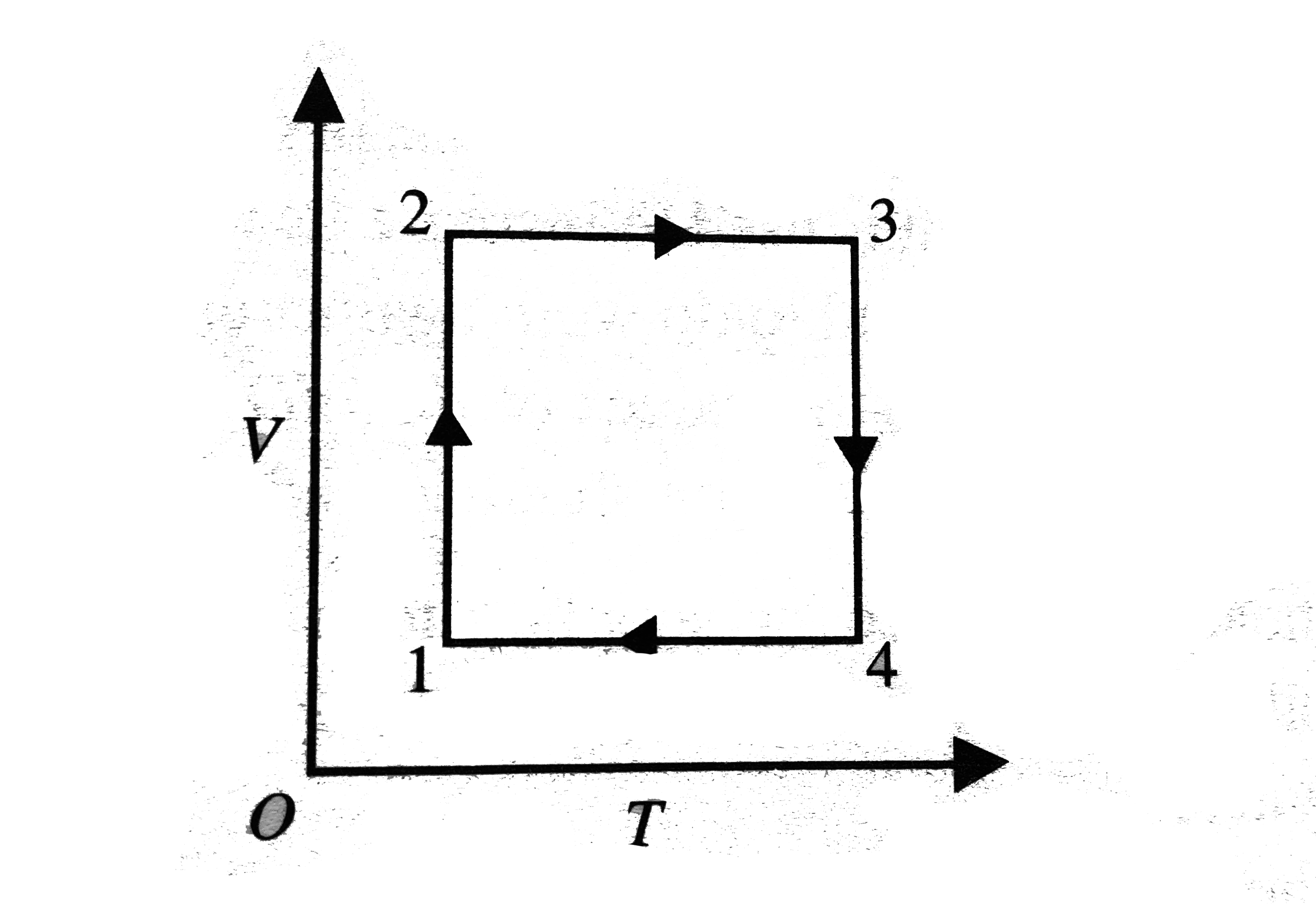Explain whether (a) T2>T1, (b) P2>P1 and (c ) V2>V1 or otherwise in Fig., which represent in isothermal, isobaric, and isochoric processes for the same mass of an ideal gas, respedtively.

As the given curve is rectangular hyperbols, its equation will be
PV=C as xy=constant.
So, gas equation PV=μRT in the light of above yields
T=PVμR=CμR
Now from Fig. C2,C1 (as for same x,y2>y1),T2>T1.
(b) As the given curve is a straight line passing through the origin with positive slope is equaiton will be
V=(tanθ)T (as y=mx)
So the gas equation PV=μT in the light of above yields
P=μRTV=μRTTtanθ=μRtanθ
Now as form Fig. we get, θ2>θ1, i.e., tanθ2>tanθ1, so P2<P1.
(c ) As the given curve is a straight line passing through the origin with positive slope, its equation will be
P=Ttanθ (as y=mx)
So gas equation PV=μRTP=μRTTtanθ=μRtanθ
Now as from Fig. we get, θ2>θ1,tanθ2>tanθ1, so V2<V1.
Topper's Solved these Questions
- KINETIC THEORY OF GASES AND FIRST LAW OF THERMODYNAMICSBook:CENGAGE PHYSICSChapter:KINETIC THEORY OF GASES AND FIRST LAW OF THERMODYNAMICSExercise:Solved Examples
Explore 14 Videos
- KINETIC THEORY OF GASES AND FIRST LAW OF THERMODYNAMICSBook:CENGAGE PHYSICSChapter:KINETIC THEORY OF GASES AND FIRST LAW OF THERMODYNAMICSExercise:Exercise 2.1
Explore 20 Videos
- KINETIC THEORY OF GASESBook:CENGAGE PHYSICSChapter:KINETIC THEORY OF GASESExercise:Compression
Explore 2 Videos
- LINEAR AND ANGULAR SIMPLE HARMONIC MOTIONBook:CENGAGE PHYSICSChapter:LINEAR AND ANGULAR SIMPLE HARMONIC MOTIONExercise:Multiple Correct Answer Type
Explore 9 Videos
Similar Questions
Knowledge Check

The plots between P and V which represent isochoric and isobaric process respectively:AI,IIBIV,ICI,IVDII,IIIIn the following diagram if V2>V1 then
 Aλ1=√λ2Bλ1<λ2Cλ1=λ2Dλ1>λ2
Aλ1=√λ2Bλ1<λ2Cλ1=λ2Dλ1>λ2The pressure-volume of varies thermodynamic process is shown in graphs:

Work is the mole of transference of energy. It has been observed that reversible work done by the system is the maximum obtainable work.
wrev>wirr
The works of isothermal and adiabatic processes are different from each other.
wisothermal reversible=2.303nRTlog10(V2V1)
=2.303nRTlog10(P2P1)
wadiabatic reversible=CV(T1−T2)
If w1,w2,w3 and w4 are work done in isothermal, adiabatic, isobaric, and isochoric reversible processes, respectively then the correct sequence (for expansion) would beAw1<w2<w3<w4Bw3=w2=w1=w4Cw3<w2<w4<w1Dw3>w1>w2>w4
A gas has been subjected to isochoric-isobaric processes 1-2-3-4-1 see Fig. Plot this process on T - V and P - T diagrams.

View SolutionA gas has been subjected to an isothermal-isochromic cycle 1-2-3-4-1 see Fig. Represent the same cycle on P - V and P - T diagrams.

View SolutionStraight line on (p - T) graph for an ideal gas represents isochoric process.
If p∝T,V=constant.
View SolutionAssertion: When ideal gas expand from P1,V1,T1, to P2,V2,T2 two steps, and work done is high in which number of steps are high
Reason: Work is path function
View SolutionFor an ideal gas, an illustratio of three different paths A(B+C) and (D+E) from an initial state P1,V1,T1 to a final state P2,V2,T1 is shown in the given figure.

Path Arepresents a reversible isothermal expansion form P1,V1 to P2,V2, Path (B+C) represents a reversible adiabatic expansion (B) from P1,V1,T1→P3,V2,T2 followed by reversible heating the gas at constant volume (C)from P3,V2,T2 to P2,V2,T1. Path (D+E) represents a reversible expansion at constant pressure P1(D) from P1,V1,T1 to P1,V2,T3 followed by a reversible cooling at constant volume V2(E) from P1,V2,T3→P2,V2,T1.
What is qrev, for path (B+C)?
View Solution


